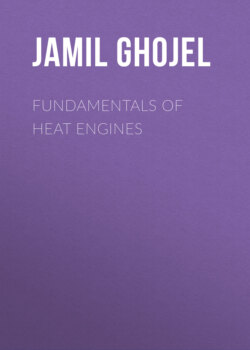Читать книгу Fundamentals of Heat Engines - Jamil Ghojel - Страница 19
1.1.4 Circular Motion
ОглавлениеRotary motion is the most convenient means for transferring mechanical power in almost all driving and driven machinery. This is particularly so in heat engine practice where thermal energy is converted to mechanical work, which is then transferred via rotating shaft to a driven machinery (electrical generator, propeller, wheels of a vehicle, pump, etc.). Consider the non‐uniform circular motion shown in Figure 1.1, in which particle P at angular position θ has linear tangential velocity v and angular velocity ω.
Figure 1.1 Non‐uniform circular motion in Cartesian coordinates: (a) initial position and velocity; (b) first‐order components of resultant acceleration; (c) second‐order components of resultant acceleration.
The components and of velocity v (= ωr) in the x and y directions are:
(1.4a)
(1.4b)
The accelerations in the same directions are
(1.5)
where are the first‐ and second‐order acceleration components in the x direction (Figure 1.1b,c).
(1.6)
are the first‐and second‐order acceleration components in the y direction.
The first‐order components of the resultant acceleration in the radial direction towards 0 is
Since ω = v/r,
(1.7a)
Radial acceleration ar is directed opposite to OP in Figure 1.1b
The second‐order components of the resultant acceleration in the tangential direction is
Since the angular acceleration ,
(1.7b)
Tangential acceleration at is directed perpendicular to OP in Figure 1.1c.
The resultant acceleration is
(1.8)
